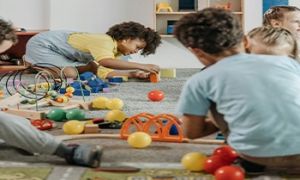The Australian 24-Hour Movement Guidelines for the Early Years provide comprehensive recommendations for physical activity, sedentary behavior, and sleep for children from birth to 5 years. The following article provides information About The Australian 24-Hour Movement Guidelines for the Early Years, Key Recommendations, and more.
About The Australian 24-Hour Movement Guidelines for the Early Years
The Australian 24-Hour Movement Guidelines for the Early Years provide comprehensive recommendations for physical activity, sedentary behavior, and sleep for children from birth to 5 years. These guidelines are designed to support healthy growth and development in young children. Here are the key recommendations:
For Infants (Birth to 1 Year)
-
Physical Activity: Engage in supervised interactive floor-based play several times a day. Aim for at least 30 minutes of tummy time spread throughout the day.
-
Sedentary Behavior: Avoid restraining infants for more than 1 hour at a time (e.g., in a stroller or car seat). Screen time is not recommended.
-
Sleep: Ensure 14-17 hours (0-3 months) and 12-16 hours (4-11 months) of good quality sleep, including naps.
For Toddlers (1 to 2 Years)
-
Physical Activity: Accumulate at least 180 minutes of physical activity at any intensity throughout the day, including energetic play.
-
Sedentary Behavior: Avoid restraining toddlers for more than 1 hour at a time. Limit screen time to no more than 1 hour per day; less is better.
-
Sleep: Ensure 11-14 hours of good quality sleep, including naps, with consistent sleep and wake-up times.
For Preschoolers (3 to 5 Years)
-
Physical Activity: Accumulate at least 180 minutes of physical activity, with at least 60 minutes of energetic play.
-
Sedentary Behavior: Avoid restraining preschoolers for more than 1 hour at a time. Limit screen time to no more than 1 hour per day; less is better.
-
Sleep: Ensure 10-13 hours of good quality sleep, with consistent sleep and wake-up times.
General Advice
-
Active Play: Encourage a variety of activities, including obstacle courses, hide and seek, dancing, and skipping.
-
Environment: Create a safe and engaging environment for active play, both indoors and outdoors.
-
Role Modeling: Parents and caregivers should model active behavior to encourage children to be active.
Key Recommendations
For Infants (Birth to 1 Year)
-
Physical Activity: Engage in supervised interactive floor-based play several times a day. Aim for at least 30 minutes of tummy time spread throughout the day.
-
Sedentary Behavior: Avoid restraining infants for more than 1 hour at a time (e.g., in a stroller or car seat). Screen time is not recommended.
-
Sleep: Ensure 14-17 hours (0-3 months) and 12-16 hours (4-11 months) of good quality sleep, including naps.
For Toddlers (1 to 2 Years)
-
Physical Activity: Accumulate at least 180 minutes of physical activity at any intensity throughout the day, including energetic play.
-
Sedentary Behavior: Avoid restraining toddlers for more than 1 hour at a time. Limit screen time to no more than 1 hour per day; less is better.
-
Sleep: Ensure 11-14 hours of good quality sleep, including naps, with consistent sleep and wake-up times.
For Preschoolers (3 to 5 Years)
-
Physical Activity: Accumulate at least 180 minutes of physical activity, with at least 60 minutes of energetic play.
-
Sedentary Behavior: Avoid restraining preschoolers for more than 1 hour at a time. Limit screen time to no more than 1 hour per day; less is better.
-
Sleep: Ensure 10-13 hours of good quality sleep, with consistent sleep and wake-up times.
General Advice
-
Active Play: Encourage a variety of activities, including obstacle courses, hide and seek, dancing, and skipping.
-
Environment: Create a safe and engaging environment for active play, both indoors and outdoors.
-
Role Modeling: Parents and caregivers should model active behavior to encourage children to be active.
Further Reading
Spontaneous Play In Early Childhood
Munch & Move Healthy Eating and Active Play
Play Active Program By Telethon Educational Institute
The Value Of Play
Reference:
Australian 24-Hour Movement Guidelines, Australian Government, Department Of Health







 As an Educator in Australia, your pay rate falls under the Children’s Services Award 2010. This award states the minimum amount that an employer can
As an Educator in Australia, your pay rate falls under the Children’s Services Award 2010. This award states the minimum amount that an employer can When working as a qualified Early Childhood Teacher (with a university degree) within a service, your rate of pay will come from the Educational Services
When working as a qualified Early Childhood Teacher (with a university degree) within a service, your rate of pay will come from the Educational Services When working as a Diploma Qualified Educator your pay rate is from the Children's Services Award 2010. This Award states your minimum rate of pay
When working as a Diploma Qualified Educator your pay rate is from the Children's Services Award 2010. This Award states your minimum rate of pay When working as a Cert 3 Qualified Educator, your pay rate is from the Children's Services Award 2010. This Award states your minimum rate of
When working as a Cert 3 Qualified Educator, your pay rate is from the Children's Services Award 2010. This Award states your minimum rate of Educational Leaders play a crucial role in their early childhood service by ensuring that the educational program aligns with best practices and supports the holistic
Educational Leaders play a crucial role in their early childhood service by ensuring that the educational program aligns with best practices and supports the holistic In early childhood education and care, ratios are more than a technicality—they are a frontline safeguard. Every child deserves responsive supervision, emotional connection, and developmental
In early childhood education and care, ratios are more than a technicality—they are a frontline safeguard. Every child deserves responsive supervision, emotional connection, and developmental With the new national child safety reforms kicking in on 1 September 2025, early childhood services like yours have a real opportunity to lead the
With the new national child safety reforms kicking in on 1 September 2025, early childhood services like yours have a real opportunity to lead the Here’s a comprehensive Mobile Phone and Smart Watch Policy tailored for early childhood education and care (ECEC) services in Australia, aligned with the latest 2025
Here’s a comprehensive Mobile Phone and Smart Watch Policy tailored for early childhood education and care (ECEC) services in Australia, aligned with the latest 2025 The Sea of Fish Challenge is a national initiative that invites children, educators, families, and communities to create and display fish artworks as a symbol
The Sea of Fish Challenge is a national initiative that invites children, educators, families, and communities to create and display fish artworks as a symbol Emotional awareness and self-regulation are crucial skills for young children, helping them navigate social interactions, manage their feelings, and develop resilience. The following article provides
Emotional awareness and self-regulation are crucial skills for young children, helping them navigate social interactions, manage their feelings, and develop resilience. The following article provides


